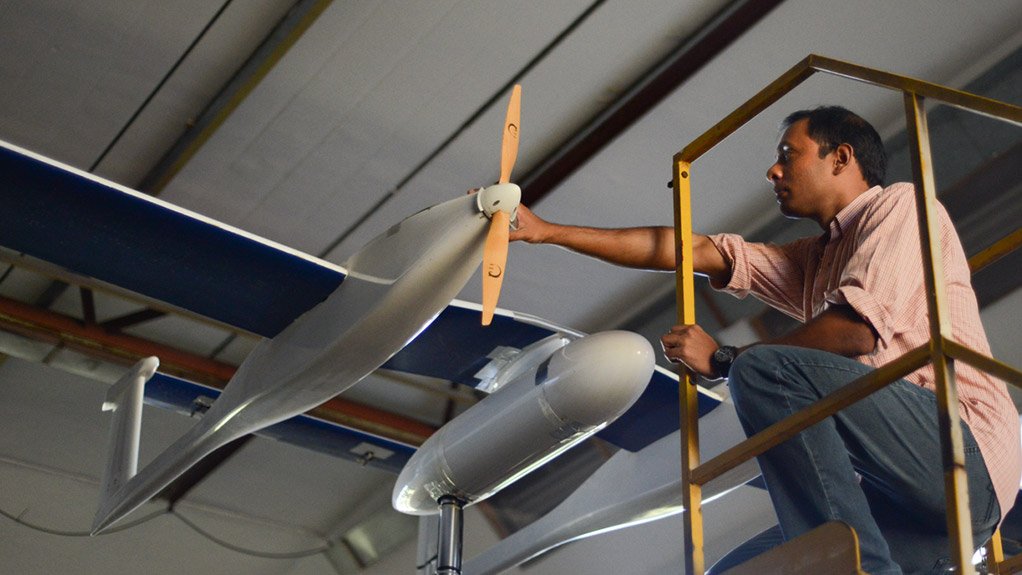African countries rapidly expanding use of UAVs, while South Africa lags


An unidentified CSIR research team member making adjustments to a CSIR-designed modular UAV
Photo by CSIR
The number of applications for unmanned aerial vehicles (UAVs)/unmanned aerial systems (UAS) in Africa is expanding rapidly, Council for Scientific and Industrial Research (CSIR) principal aeronautical engineer John Monk told the aviation session of the Southern African Transport Conference in Pretoria on Wednesday. (A UAV is the actual unmanned aircraft while a UAS is that aircraft plus datalink plus ground control station plus – in some cases – UAV launch and retrieval systems.)
“UAS originally had three missions – [the] dull, dirty, and dangerous,” he noted. Today, they had very many more roles.
An important UAS application in Africa is medical sample, medication and blood transport. A US company, Zipline, was now doing this routinely, on a nation-wide basis, in Rwanda. This was providing rapid support to clinics in rural areas. The service was now being expanded to Tanzania. A Dutch company, Dr.One, was developing a similar system for use in Malawi.
These programmes are largely funded by international donors, both private and public, national and multinational. Dr.One, for example, has funding from the United Nations, the Dutch government and, strikingly, the Ghanaian government.
Ironically, the use of UAVs to transport medical samples had been proven in South Africa, Monk highlighted. This had been done in trials by University of the Witwatersrand Professor Barry Mendelow in 2008. But South African Civil Aviation Authority regulations at that time did not allow this to be done on a regular basis, only experimentally.
But UAVs were being put to many other uses in Africa today, Monk pointed out. In the Sudan, they were being used to sow acacia tree seeds to reduce desertification. In Botswana, commercially-available quadcopters were employed to drive elephants away from villagers’ crops. In Nigeria, UAVs were being used to carry out aerial surveys of archaeological sites.
Not least, in Ethiopia, UAVs were used to release sterilised male tsetse flies, which then mated with females, which consequently did not produce any offspring. This was an environmentally-friendly way of reducing the numbers of these insects, which transmit sleeping sickness and other diseases.
South Africa now had regulations that allowed regular use of UAVs – Part 101 of the Civil Aviation Regulations. But, he observed, these were seen as being onerous, and making it slow and expensive to qualify to operate UAVs. As a result, there were currently only 26 licensed UAV operators in South Africa.
In consequence, South Africa was falling behind other countries in making use of UAVs. These included other African countries, a significant number of which (especially in Southern Africa) now also had UAV regulations.
The CSIR had been involved in UAV research and development for many years, he stressed. “We have designed 15 to 16 airframes over the years.” CSIR Aeronautics’ activities included the design of new and/or novel UAV airframes and the analysis and characterisation of existing UAVs. Its current projects included the Long Endurance Modular UAV (LEMU for short), of which there were two versions.
Comments
Press Office
Announcements
What's On
Subscribe to improve your user experience...
Option 1 (equivalent of R125 a month):
Receive a weekly copy of Creamer Media's Engineering News & Mining Weekly magazine
(print copy for those in South Africa and e-magazine for those outside of South Africa)
Receive daily email newsletters
Access to full search results
Access archive of magazine back copies
Access to Projects in Progress
Access to ONE Research Report of your choice in PDF format
Option 2 (equivalent of R375 a month):
All benefits from Option 1
PLUS
Access to Creamer Media's Research Channel Africa for ALL Research Reports, in PDF format, on various industrial and mining sectors
including Electricity; Water; Energy Transition; Hydrogen; Roads, Rail and Ports; Coal; Gold; Platinum; Battery Metals; etc.
Already a subscriber?
Forgotten your password?
Receive weekly copy of Creamer Media's Engineering News & Mining Weekly magazine (print copy for those in South Africa and e-magazine for those outside of South Africa)
➕
Recieve daily email newsletters
➕
Access to full search results
➕
Access archive of magazine back copies
➕
Access to Projects in Progress
➕
Access to ONE Research Report of your choice in PDF format
RESEARCH CHANNEL AFRICA
R4500 (equivalent of R375 a month)
SUBSCRIBEAll benefits from Option 1
➕
Access to Creamer Media's Research Channel Africa for ALL Research Reports on various industrial and mining sectors, in PDF format, including on:
Electricity
➕
Water
➕
Energy Transition
➕
Hydrogen
➕
Roads, Rail and Ports
➕
Coal
➕
Gold
➕
Platinum
➕
Battery Metals
➕
etc.
Receive all benefits from Option 1 or Option 2 delivered to numerous people at your company
➕
Multiple User names and Passwords for simultaneous log-ins
➕
Intranet integration access to all in your organisation



















